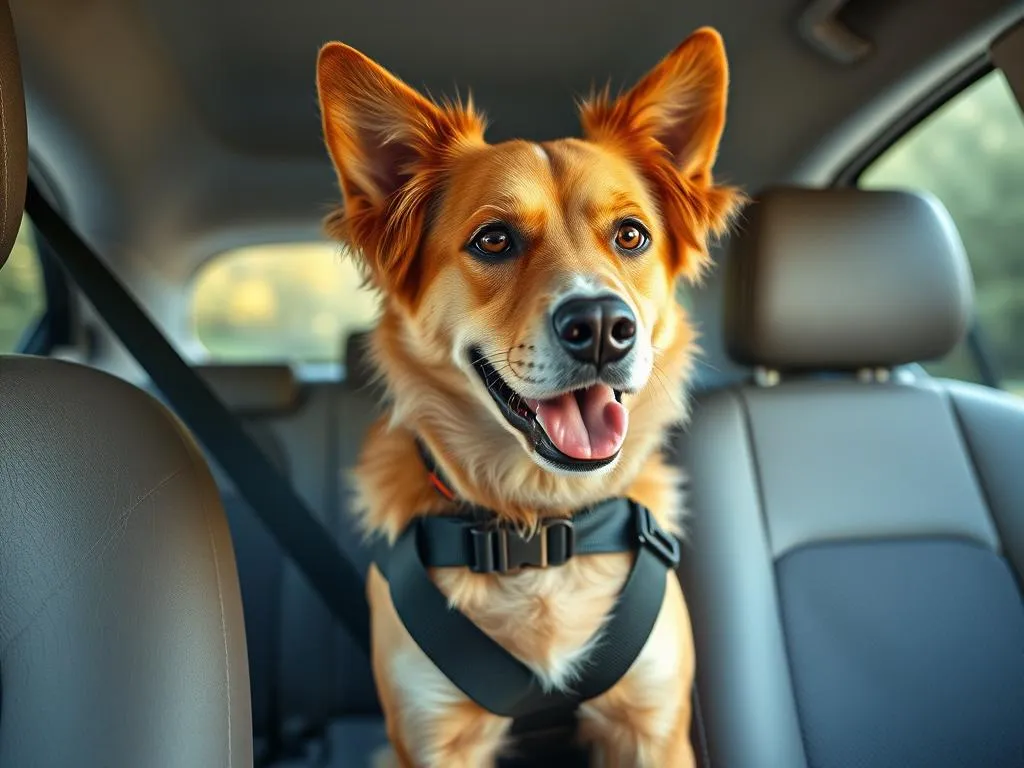
Traveling with your furry friend can be one of life’s greatest joys. Whether it’s a quick trip to the vet or a long road trip, your dog deserves to feel safe and secure while on the road. One of the best ways to ensure their safety is by using dog seat belts. These essential tools not only protect your pet but also contribute to overall road safety. In this guide, we’ll explore the best dog seat belts available on the market today, ensuring that you have all the information you need to make an informed choice.
Understanding Dog Seat Belts
What Are Dog Seat Belts?
Dog seat belts are specialized harnesses designed to secure your pet during car travel. Unlike standard human seat belts, which are designed to restrain a human body, dog seat belts are tailored to fit the unique shape and size of a dog. Typically, they feature adjustable straps and clips that attach to the car’s seat belt system, keeping your furry friend safely restrained in their seat.
Why Use a Dog Seat Belt?
Using a dog seat belt is vital for several reasons. First and foremost, they enhance safety for both the dog and the passengers in the vehicle. In the event of a sudden stop or an accident, a secured dog is less likely to become a projectile, which can result in severe injuries to both the pet and human occupants.
Additionally, many regions have legal requirements regarding pet restraint in vehicles. Failing to comply with these laws can lead to fines or other legal consequences. By using a dog seat belt, you not only ensure your pet’s safety but also adhere to the law.
Key Features to Look for in Dog Seat Belts
Material and Durability
When selecting a dog seat belt, it’s crucial to consider the materials used in its construction. High-quality materials, such as heavy-duty nylon or durable polyester, are essential for ensuring that the seat belt can withstand the pressure of sudden stops or accidents. Look for options that have reinforced stitching, as this adds to the overall durability of the product.
Size and Adjustability
Proper sizing is critical to the effectiveness of a dog seat belt. Make sure to measure your dog accurately, taking into account their weight and body shape. An adjustable seat belt is ideal, allowing you to customize the fit for maximum comfort and security. A poorly fitted seat belt may not only be ineffective but could also be uncomfortable for your pet.
Safety Ratings and Certifications
Not all dog seat belts are created equal when it comes to safety. Look for products that have undergone crash testing and have safety ratings from reputable organizations. These certifications provide assurance that the product meets specific safety standards and can protect your pet during travel.
Ease of Use
A dog seat belt should be user-friendly. Features such as quick-release buckles, adjustable straps, and compatibility with various car seat belts make installation and removal simple. The easier it is to use, the more likely you are to keep your dog secured during car rides.
Top Dog Seat Belts on the Market
Best Overall Dog Seat Belt
One standout in the world of dog seat belts is the Ruffwear Load Up Harness. This product combines comfort, security, and ease of use. Made from durable materials, the harness distributes pressure evenly across the dog’s body, reducing the risk of injury during a sudden stop.
Pros:
– Excellent durability
– Comfortable fit
– Easy to install
Cons:
– Higher price point compared to some options
Best Budget Option
For those looking for an economical solution, the PetSafe Happy Ride Seat Belt is a fantastic choice. This budget-friendly option is made from durable nylon and easily attaches to your car’s seat belt system.
Pros:
– Affordable price
– Easy to use
– Adjustable length
Cons:
– May not be as durable as higher-end options
Best for Large Dogs
If you have a large breed dog, the Buckle-Down Seat Belt is designed specifically with their needs in mind. This heavy-duty seat belt features a robust design that can withstand the strength of larger dogs while keeping them secure during travel.
Pros:
– Strong and durable
– Safety-tested for large breeds
– Easy attachment to the car’s seat belt
Cons:
– Bulkier than other options
Best for Small Dogs
For smaller breeds, the Mighty Paw Dog Seat Belt is an excellent choice. This lightweight yet strong seat belt is designed to keep small dogs safe while providing comfort during the ride. It boasts a universal fit that works with all car seat belts.
Pros:
– Lightweight and comfortable for small dogs
– Easy to use
– Affordable
Cons:
– Not suitable for larger breeds
Best Dog Seat Belt for Multiple Dogs
If you’re traveling with more than one dog, the PetSafe Adjustable Dog Seat Belt is a great solution. This product allows you to secure multiple pets in the car, keeping them safe and preventing distractions for the driver.
Pros:
– Accommodates multiple dogs
– Adjustable length for each dog
– Durable design
Cons:
– May require additional adjustments for comfort
How to Properly Use a Dog Seat Belt
Step-by-Step Guide
- Choose the Right Seat Belt: Select a dog seat belt that fits your dog’s size and weight.
- Read the Instructions: Familiarize yourself with the manufacturer’s instructions for installation.
- Attach the Seat Belt: Secure the seat belt to your car’s existing seat belt system or harness.
- Adjust for Comfort: Ensure the seat belt is adjusted properly so your dog can sit comfortably while being secured.
- Check the Fit: After installation, check that the seat belt is snug but not too tight. Your dog should be able to move comfortably without being able to roam around the vehicle.
Common Mistakes to Avoid
Many pet owners make mistakes when using dog seat belts. One common error is not properly sizing or adjusting the seat belt, which can lead to discomfort or ineffectiveness. Another mistake is failing to secure the belt correctly, which can compromise safety. Always double-check that the seat belt is secure before hitting the road.
Training Your Dog for Car Travel
To ensure a smooth experience, it’s important to acclimate your dog to using a seat belt. Start with short car rides, rewarding your dog for good behavior. Gradually increase the length of trips, allowing your dog to become accustomed to the feeling of being secured. Use treats and positive reinforcement to make the experience enjoyable for your pet.
Additional Safety Tips for Traveling with Dogs
Preparing for Longer Trips
Planning for longer trips with your dog requires some additional considerations. Make sure to take regular breaks to allow your dog to stretch, relieve themselves, and hydrate. Packing essential items, such as food, water, and a first aid kit, can help ensure a safe and enjoyable journey.
Emergency Preparedness
In the unfortunate event of an accident, being prepared can make all the difference. Have a pet emergency kit on hand that includes basic medical supplies, your veterinarian’s contact information, and any necessary medications for your dog. Familiarize yourself with emergency procedures and make sure you know how to handle your pet in case of an accident.
Conclusion
Choosing the right dog seat belt is a crucial step in ensuring the safety of your furry friend during car travel. With various options available on the market, understanding your pet’s needs and preferences will help you make the best choice. Remember to consider factors such as material, size, and safety ratings when selecting a product. By investing in a quality dog seat belt, you can enjoy peace of mind knowing that your dog is safe and secure while you travel together.
FAQs about Dog Seat Belts
Are dog seat belts necessary?
Yes, dog seat belts are essential for the safety of both your pet and the passengers in the vehicle. They help prevent injuries during sudden stops and comply with legal pet restraint requirements.
Can I use a regular harness instead?
While a regular harness may provide some level of restraint, it is not designed for car travel. Dog seat belts are specifically engineered to keep your pet secure during vehicle movement, making them the safer option.
What to do if my dog resists wearing a seat belt?
If your dog is reluctant to wear a seat belt, start by introducing it slowly. Allow them to sniff and explore the harness outside of the car. Use treats and praise to create a positive association with the seat belt, and gradually increase the time they wear it.
How often should I replace my dog’s seat belt?
Regularly inspect your dog seat belt for wear and tear. If you notice any frayed edges or damage, it’s time to replace it. Additionally, if you get a new dog or your dog has outgrown their current seat belt, consider investing in a new one.
Are there any dog seat belts that also function as harnesses?
Yes, many dog seat belts double as harnesses. These multifunctional options provide the safety of a seat belt while allowing for comfortable walking outside of the car. Look for products that specify dual functionality for the best of both worlds.
Traveling with your dog doesn’t have to be a stressful experience. With the right dog seat belt, you can create a safe and enjoyable environment for both you and your furry companion.









